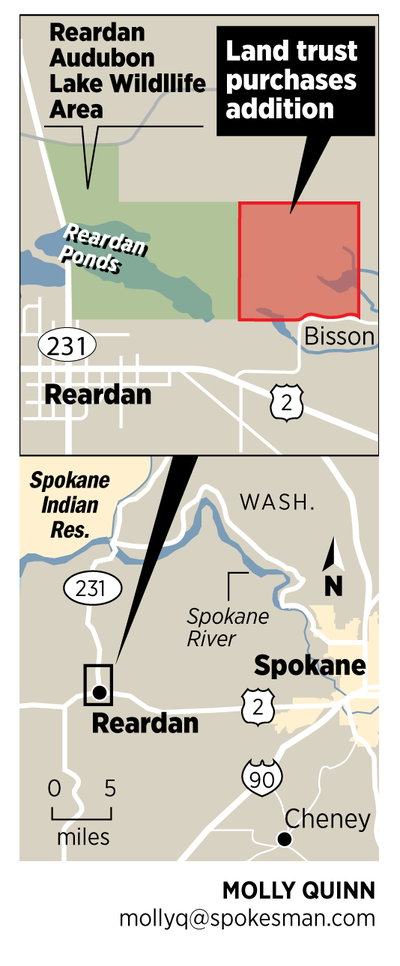Landers: Reardan wildlife area shows what community effort can accomplish

It takes a village to maintain wildlife in a developing world – especially the far-flung migrants that span the continent each year.
Reardan Audubon Lake Wildlife Area is a model of what a group effort can accomplish.
A nonprofit land trust stepped up last week to secure wetlands important to migrating waterfowl and other birds in Lincoln County along U.S. 2 west of Spokane. But that’s just the latest chapter in the story.
First, the importance of the 80-acre lake and associated wetlands had to be discovered.
Today the wildlife area is a stop on the Northeast Washington Birding Palouse to Pines Trail developed by Audubon Washington. It’s also a notable feature on the Ice Age Floods National Geologic Trail.
However, the big picture wasn’t obvious to everybody. Spokane Audubon Society birding leaders, such as Jim Acton and the late Warren Hall, started documenting the wide variety of waterfowl and shorebirds that visit Reardan as early as the 1950s.
Decades of record keeping helped make the case for acquiring 277 acres of the wetland complex in 2006 to become the Reardan Audubon Lake Wildlife Area managed by the state Department of Fish and Wildlife.
Drivers passing through the town of Reardan can easily see the flocks of tundra swans, geese, ducks and gulls that rest on the lake in spring and fall migrations. But the priceless nature of the wetlands, bordered by aspens and cottonwoods, was assessed by the trained eyes of bird watchers who stop to admire the shorebirds, including three species that breed at Reardan.
“The American avocet and Wilson’s phalarope nest there,” said Kim Thorburn, an expert Audubon birder, “as well as the especially beautiful black-necked stilt” – an extraordinarily tall, sleek, long-billed bird with mostly black and white plumage and relatively long, slender, gorgeous red legs.
Equally attractive to birders are the migrants and the surprises they deliver, including rare sightings in recent years of the white-rumped sandpiper, an East Coast bird that’s in decline.
During spring migration, birds tend to be in a rush to get to breeding grounds. Their pit stops at Reardan tend to be brief and raucous.
The slower-paced fall migrations are the best time to spot traveling shorebirds that start stopping over and feeding along Reardan Lake mud flats in early August.
“Most of these birds are arctic breeders,” Thorburn said. “Year-round potholes are critically important to them because resting spots are getting more rare.”
Many of the region’s potholes have disappeared in the past 50 years, the result of draining to provide more pasture and farm land or the consequence of deep-well irrigation that’s lowering the channeled scablands’ water table.
“Having dependable resting spots is important for species migrating from the arctic as far south as Argentina,” Thorburn said. “Sure, Rock Lake has year-round water, but it’s rimmed by steep basalt walls instead of the muddy shoreline found at Reardan. That’s what shorebirds need.”
The village effort to protect the wildlife values of Reardan Audubon Lake continued in recent years, spearheaded by local Audubon member Lindell Haggin, who worked with a landowner to shore up more protected land.
“We were concerned about the possibility of development – houses and dogs – creeping in along the wetlands and degrading the value of the wildlife area,” said Mike Atamian, the state’s area wildlife biologist.
The Inland Northwest Land Trust added its expertise to negotiate an agreement with a willing seller and purchase 150 acres adjoining the existing wildlife area.
The Spokane-based land trust plans to sell the property to the Department of Fish and Wildlife when funds become available. The deal assures the area’s wetlands, 13 vernal pools, alkaline mud flats and basalt features will remain undeveloped.
Garry Schalla, INLT executive director, said state wildlife officials were given an option by the owner last year to buy the land, but the state needs about two years or more to apply for state funding through the Washington Wildlife and Recreation Program.
“INLT was the lead organization in the original 2006 acquisition, so when Audubon and WDFW called on us, we were glad to help out,” said Chris DeForest, INLT conservation director. The deal was closed Jan. 15.
The 80-acre main lake and wetlands on the north side of Reardan are at the headwaters of Deep Creek and Crab Creek.
“It’s year-round water, which is so important,” Atamian said.
“Although most of our work is to help private individuals conserve their own land, this will eventually be a public preserve,” Schalla said.
A team of other players – including Turnbull National Wildlife Refuge, the U.S. Bureau of Land Management and Ducks Unlimited – are joining the state to assess other water bodies in the region for their value to migrations. “The goal is to target our money and restoration efforts where they will be most effective,” Atamian said.
The Land Trust plans to clean up the new addition and work with state and local agencies and organizations to design a trail system that gives birders and school groups access to viewing the wildlife while shielding sensitive areas, he said.
“It’s a critical stop for wildlife and a valuable classroom that’s readily accessible to the public,” Atamian said.
Contact Rich Landers at (509) 459-5508 or email richl@spokesman.com.